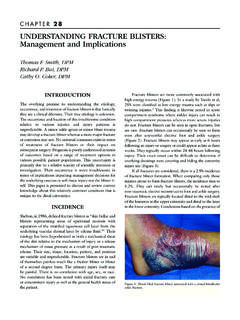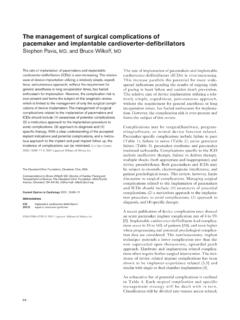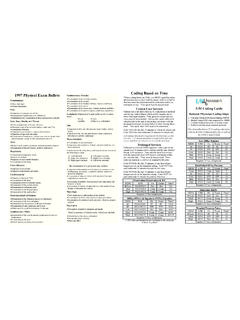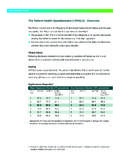Transcription of ED Inspection Guide Offshore - hse.gov.uk
1 Page 1 of 122 ED Inspection Guide Offshore Inspection of Loss of Containment (LOC) Open Government status: Fully Open Target audience: HSE ED Inspectors CONTENTS Summary Introduction Action Background Applicable Legislation Contacts Appendix 1: Process plant design, construction and commissioning Appendix 2: Process plant operation within safe limits Appendix 3: Instrumented Protection Systems Appendix 4: Relief, blow-down and flare systems Appendix 5: Process isolations Appendix 6: Plant re-instatement following maintenance or idle phase Appendix 7: management of change Appendix 8: Other Offshore process hazards Appendix 9: Monitoring and review arrangements Appendix 10: Positive process safety culture Appendix 11: Floating production, storage and offloading (FPSO) Installations Appendix 12: management of small bore tubing, piping and flexible hoses Appendix 13: Duty holder performance assessment SUMMARY This document is intended to provide guidance to Energy Division staff to support Inspection of loss of containment risk at Offshore oil and gas installations.
2 It describes a number of key elements which contribute to effective management of the risks, based on research into root causes of previous incidents, and published industry codes, standards and good practice. It also identifies relevant legislation, matters of evident concern, benchmark standards and examples of good practice for each element, in order to support performance assessment. Areas where additional specialist support may be useful or necessary are identified. Page 2 of 122 It is important to note that the Guide does not cover a number of aspects which are fundamental to management of loss of containment risk, where the technical lead is taken by other HSE specialist teams, and/or other Inspection guidance exists. This includes for example the design, Inspection and maintenance of pressure systems, control of work (including permit to work) and several human factors topics.
3 INTRODUCTION The aim of this Inspection Guide (IG) is to provide information and guidance to Offshore inspectors to support the delivery of consistent and effective Inspection of process safety systems which protect against loss of containment. It does this by highlighting current key areas to be covered during inspections, providing a framework for inspectors to judge compliance, assign performance ratings, and decide what enforcement action to take should they find legislative breaches. In doing so, it complements HSE s Enforcement Policy Statement (EPS) and Enforcement management Model (EMM). Various regulations (described more specifically later) place duties on operators of Offshore installations to take measures to minimise the risk of a loss of containment of flammable, toxic or hazardous substances. These measures must be effective throughout the installation s lifecycle, and under all foreseeable plant conditions This Guide is split into twelve core intervention areas as follows: 1 Process Plant design, construction and commissioning 2 Process Plant operation within safe limits 3 Instrumented Protection Systems 4 Relief, Blow-down and Flare systems 5 Process Isolations 6 Plant Re-instatement following Maintenance or Idle Phase 7 management of Change 8 Other Offshore Process Hazards 9 Monitoring & Review Arrangements 10 Positive Process Safety Culture 11 Floating Production, Storage and Offloading (FPSO Installations) 12 management of small bore tubing, piping and flexible hoses An overview of each of the above will be provided in appendices 1-12.
4 The effectiveness of the measures taken under each area is key to ensuring that a duty holder minimises the likelihood of a major accident hazard occurring. Appendix 13 provides generic guidance on assessing duty holder performance using the Inspection Guide . ACTION Page 3 of 122 A complete Inspection of this topic requires all intervention areas to be addressed, although some may be of greater relevance to a particular installation given its inherent hazards, performance history and position within its own lifecycle. For the purposes of assessing the performance of a duty holder, the scope of the intervention areas to be inspected should be agreed in advance between the IMT and other specialist inspectors assigned. Individual appendices provide detail on relevant standards and good practice that are expected in general terms, but inspectors will need to devise suitable question sets and other Inspection approaches to assess the level of compliance against the quoted benchmarks, based upon the scale and nature of hazard at particular installations.
5 BACKGROUND ED s main concern is the prevention of major hazard incidents, in which workers are killed or injured. Major fires and explosions, such as those that occurred on Piper Alpha and Macondo (Deepwater Horizon), have been initiated by releases of hydrocarbons. As such, the effective design and implementation of measures to prevent such losses of containment is fundamentally important. Typical sources of hydrocarbon releases (HCRs) are the well, the pipeline riser, other pipelines and pipe work and associated process plant. Releases can occur from either failure of the asset itself due to corrosion, abrasion or fracture, or because of failures of maintenance poor practice when breaking and re-making joints, or insufficient operational controls. HCRs can also result from damage due to other failures dropped objects during crane operations. TARGETING Inspections should be planned within the timescales set out by ED divisional management .
6 Although inspections may be carried out at any installation, it is particularly important to carry this out where there are known issues that may affect process integrity, such as ageing equipment, major work over projects etc. It is essential to ensure that duty holders are robust in their assessment of the implications of these factors, that suitable mitigations are in place and that cumulative risk factors have been considered. TIMING Inspectors should undertake loss of containment interventions as part of the agreed ED Offshore intervention plan, when intelligence indicates intervention is necessary, or when investigation due to incident is required. RESOURCES (Process Engineering) has overall ownership of the Guide , and takes the lead on inspecting several of the elements. Some however are more closely aligned to other specialist teams (such as EC&I for appendix 3, and Page 4 of 122 Mechanical Integrity for appendix 12).
7 Appendices 7, 9 and 10 describe Inspection of particular process aspects of duty holders SEMS, and as such are closely aligned with IMT. Most of the elements will benefit from a multidisciplinary approach to their Inspection . RECORDING AND REPORTING The duty holder performance ratings should be entered on the Inspection Rating Form (IRF) tab of the relevant installation Intervention Plan Service Order. Findings should be recorded in the normal post Inspection report and letter. APPLICABLE LEGISLATION The table overleaf provides a cross reference of applicable legislation against the relevant sections of this Inspection Guide . All legislation is available to download from A list of applicable HSE publications, Approved Code of Practice, is also provided with these documents available from SPECIALIST ADVICE ED can provide general/initial advice on all of the elements. Other units may however be able to provide additional or more authoritative guidance for particular aspects related to their discipline, as suggested below.
8 Appendix Title ED Unit 1 Process Plant Design, Construction and Commissioning ED 2 Process Plant Operation within Safe Limits ED 1/ED 3 Instrumented Protection Systems ED 4 Relief, Blow-down and Flare Systems ED 5 Process Isolations ED 6 Plant Re-instatement following Maintenance or Idle Phase ED 7 management of Change ED 1 9 Monitoring & Review Arrangements ED 1 10 Positive Process Safety Culture ED 1/ ED 11 Floating Production, Storage and Offloading (FPSO) Installations ED 12 management of Small Bore Tubing, Piping and Flexible Hoses ED Page 5 of 122 Note: that the Health and Safety at Work etc. Act 1974, Sections 2(1) and 3(1) outline the overarching duty and is applicable to all sections of this Guide . Regulation Loss of Containment Guide Section 1 2 3 4 5 6 7 8 9 10 11 12 13 Control of Substances Hazardous to Health Regulations, 2002 Regulation 6 X Regulation 7 X management of Health and Safety at Work Regulations, 1999 Regulation 3 X X X X X Regulation 4 X Regulation 5 X X X X X X X X X X X Regulation 10 X Regulation 11 X Regulation 13 X Offshore Installations (Prevention of Fire and Explosion, and Emergency Response) Regulations, 1995 Regulation 4 Regulation 5 X X X Regulation 9 X X X X X X X X X X X Regulation 10 X Regulation 12 X Regulation 19 X X X X X X Regulation 21 X Offshore Installations and Pipelines Works ( management and Administration) Regulations, 1995 Regulation 11 X X Offshore Installations and Wells (Design and Construction, etc)
9 Regulations, 1996 Regulation 5 X Regulation 6 X Regulation 7 X Offshore Installations ( Offshore Safety Directive) (Safety Case etc) Regulations, 2015 Regulation 7 X Regulation 8 X Regulation 32 X Provision and Use of Work Equipment Regulations, 1998 Regulation 4 X Regulation 5 X X X Regulation 6 X X X Regulation 8 X X X X X Regulation 9 X X X X Regulation 12 X Regulation 23 X X Page 6 of 122 APPENDIX 1 PROCESS PLANT DESIGN, CONSTRUCTION AND COMMISSIONING Scope This guidance applies to the Inspection of systems which provide safety assurance for the design, construction and commissioning phases of Offshore oil or gas production process plant. A) PROCESS PLANT DESIGN Fundamental Requirements The design of a process plant is a complex activity that will usually involve many different disciplines over a considerable period of time.
10 The design may also go through many stages from the original research and development phases, through conceptual design, detailed process design and onto detailed engineering design (drawings, calculations, specifications etc.) and equipment selection. Many varied and complex factors including safety, health, the environment, economic and technical issues may have to be considered before the design is finalised. At each stage it is important that the personnel involved have the correct combination of technical competencies and experience in order to ensure that all aspects of the design process are being adequately addressed. The principles of inherently safer design are particularly important for major hazard plants and should be considered during the design stage where there is the greatest potential for reducing the risk of loss of containment, in an effort to reduce the hazard potential of the plant. Consideration should be given to processing hydrocarbons under conditions that make the materials less hazardous ( at lower temperatures and pressures).

















